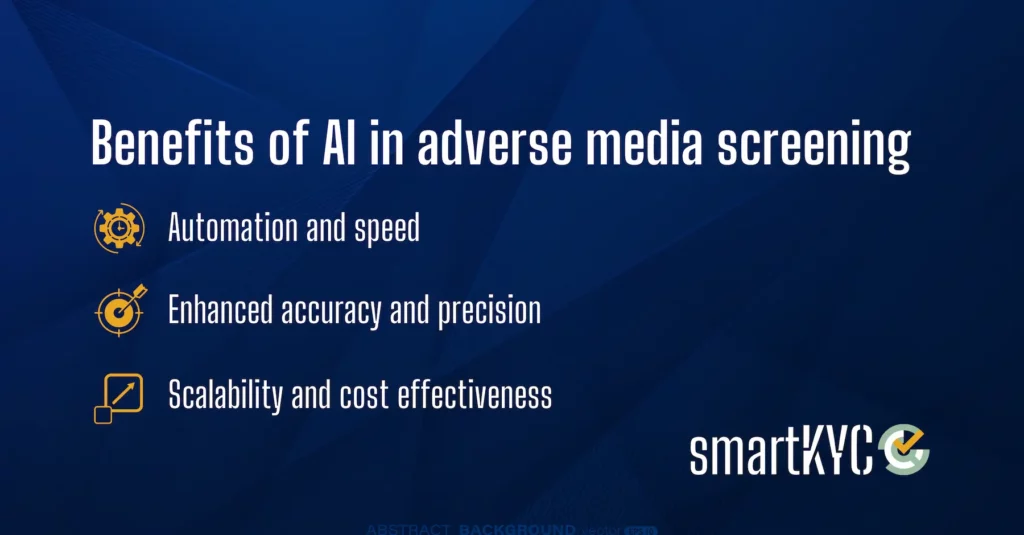What is adverse media screening?
Adverse media screening is the process of searching for negative news or media about an individual or company for due diligence purposes. Negative news or adverse media can be found in unstructured data or open source intelligence online; that includes news articles, blogs, social media, and other publicly accessible data sets.
However, what exactly falls into the ‘adverse’ category? It generally means information that is harmful or unfavourable towards a person or company. But effective adverse media monitoring divides these general terms into categories and subcategories to achieve accurate and relevant results.
These can include financial crime, mainly money laundering, as well as corruption and bribery, and different forms of fraud, such as embezzlement and tax evasion.
Other categories include reputational risks, toxic associations with third parties and ESG compliance. These may not refer to criminal behaviour, but are equally important to screen for as they can have a severe impact on the perception of your company.
Risk and reputation: Why negative news screening is key
Protecting the reputation of your organisation is one of the many reasons continuous adverse media checks are essential; they also allow you to identify risks to safeguard your customers and partners. Last but not least, adverse media screening is a key part of KYC and anti-money laundering processes, which are required by regulatory agencies.
But these negative news screenings can produce an unmanageable amount of data. That’s where AI comes in; Al algorithms, specifically natural language processing, can be used to analyse and classify large volumes of unstructured data. This results in a more efficient and effective process of adverse media checks, with less risk of human error.
Why traditional adverse media checks are not enough
In our article about the history of adverse media screening we delve into how this process has evolved from reviewing print newspapers and magazines manually, to using AI to screen large amounts of data obtained from a number of digital sources.
Traditional adverse media screening methods left too much room for error and required a full time team; and as the amount of available information and sources increased substantially, they simply stopped being fit for purpose.
The first negative media monitoring softwares used keywords and later proximity searches, neither of which prevent important information slipping through the cracks, or solve the issue of having to manually sort through ‘false’ or irrelevant results. This all leaves institutions open to risk.
How AI goes beyond to offer faster, more accurate results
The shortcomings of traditional adverse media monitoring tools result in inefficiency, frustration and a lack of confidence in the work done. In contrast, AI powered solutions can result in faster, better and more cost-effective adverse media screening processes.
AI, specifically Natural Language Processing (NLP), goes much further than keyword and proximity searches ever could. NLP technology can decipher, analyse, and emulate human language in a contextually relevant and purposeful manner.
In other words, NLP can understand and contextualise unstructured data, like online media, so that the search is thorough, accurate and only pertinent and risk relevant facts are presented for human review, whilst not missing any red flags.
By leveraging AI and machine learning, businesses can also identify emerging and potential risks more effectively, ultimately leading to better decision-making and risk-management strategies.

The benefits of AI in adverse media screening:
- Automation and speed: Thousands of news articles are machine-read and analysed for relevance in minutes, and in real time. In addition, factual intelligence is extracted from all the documents so analysts can do their jobs more quickly.
- Enhanced accuracy and precision: Hits are scored for relevance based on a match with all identifying attributes, not just a name, thereby reducing false positives. Every potentially relevant document is read – nothing is missed and results are always live, never curated.
- Scalability and cost-effectiveness: Less human effort needs to be spent on laborious and time-consuming adverse media monitoring. Getting accurate results from the start also means less requirement for expensive remediation exercises.
What is Multilingual Natural Language Processing (NLP)?
Multilingual NLP is a technology that incorporates linguistics, computer science, and AI to process and analyse large amounts of natural human language in various contexts.
Essentially, Multilingual NLP allows for computational programs to understand the language of a document, as well as contextual nuances. In other words, this technology can machine-read documents and articles as a human would, but with far greater speed; it also has the ability to extract precise information and provide key insights.
This software’s ability to catch language nuance is also what makes it a truly efficient tool for adverse media screening in multiple languages. Unlike tools like Google Translate, Multilingual NLP can understand the gap between content translation and real meaning.
What’s more, Turkish, Arabic and Asian languages are typically more difficult to translate than Latin languages due to structure patterns. This often results in inexact translations that can change negative news screening results. Multilingual NLP overcomes this challenge, delivering more precise results.
Conclusion
Adverse media screening can help organisations meet increasing regulatory requirements and show they are actively committed to responsible compliance. Effective, AI-powered screening also saves time and money: it helps companies stay ahead of reputational risks, so they can prevent or efficiently manage any crisis in time, and avoid fines or even drops in stock value related to negative perceptions from the public.
AI solutions like Multilingual NLP provide KYC and CDD professionals with renewed confidence in screening results — no more wondering if an alert is worth investigating, or if they’ve missed some key information.
AI has the potential to revolutionise negative news screening thanks to its ability to analyse and classify data in real time, and with much more accuracy than previous technologies.
Why choose smartKYC?
smartKYC’s adverse media screening software is the world’s most advanced multilingual semantic search engine to machine read all online media content for potential negative news, improving KYC processes and reducing risks.
Combining the technologies of federated search with Multilingual NLP, sophisticated name matching and unique identity matching, smartKYC is faster, better and more cost effective than any other solution on the market.
